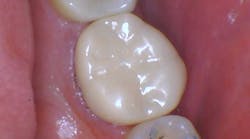Instagram: @grandviewdental
Facebook: @grandviewdentalcare
The gist:
Follow this formula to achieve a predictable single-visit crown appointment with easy-to-read margins.
This is a step-by-step of how I deliver a straightforward single-unit crown in one appointment. The large amalgam restoration in no. 19 was failing with recurrent decay and loss of marginal integrity. We chose to restore using CEREC Primescan and Primemill (Dentsply Sirona) with a Katana zirconia block (Kuraray Noritake). We also restored no. 30 in exactly the same fashion at this appointment. Treatment time was just over 2.5 hours.
I use an Isodry (Zyris) for isolation and retraction when doing single-appointment crowns, because it makes scanning easier and provides nice cheek and tongue retraction. I start all crown preparations with occlusal reduction using a 2 mm occlusal router bur (Meisinger). This allows me to be sure I have enough reduction and don’t have to take the Isodry out to check clearance prior to scanning.
I make three grooves, and then I connect the dots with that same bur. Next, I break contact with a 245 carbide. I stop prepping here and get cord packed. I use 00 and 2 cord (Ultradent) on most molars. We keep precut lengths of cord soaking in bottles of Hemodent that we pull out per patient. I build up most teeth back to ideal using Clean & Boost (Vista Apex), Scotchbond Universal (3M), and Anchor Core Build-Up (Vista Apex).
I finish my prep with a 1.8 mm coarse chamfer diamond. The top cord is pulled and a digital impression is captured with Primescan. We milled the crown in the Primemill, polished, and then sintered in the SpeedFire oven (Dentsply Sirona). We cemented the crown with RelyX Luting Plus (3M).
For me, the key to predictability is to use the same steps each time so there is no lost motion, and my assistant can hand me things without even being asked. The two-cord technique is especially important for predictable impressions. The secret is to pack them both as soon as contact is broken. This gives hemostasis, helps me to visualize my margin, and allows time for good retraction to happen. Impressions are slam dunks (either analog or digital) using this technique.
Photo legend
Figure 1: This amalgam has outlasted its usefulness.
Figure 2: Depth cuts with occlusal router bur
Figure 3: Finish occlusal reduction with same router bur
Figure 4: I like to only break contact prior to packing cord
Figure 5: #00 cord in place and the rest of the old stuff removed
Figure 6: Barely into the little sulcus
Figure 7: #2 cord in place. I like both cords in at this point because it lets me see my margin better, provides hemostasis, lets me identify any overhanging tissue that needs to be trimmed away, and makes the buildup easier. It also gives it time to provide great retraction for the scan.
Figure 8: I didn't prep the whole buccal so I didn't need to shove the #2 down into that thin gingiva.
Figure 9: I freehand my buildup to roughly the shape of my prep. This is right before curing.
Figure 10: Final prep ready to pull the #2 and scan
Figure 11: Scan of the prep in Primescan
Figures 12, 13, and 14: Final zirconia crown cemented
ABRAHAM HOELLRICH, DDS, is the owner of Grandview Dental Care located in Columbus, Ohio. He graduated from the Ohio State University College of Dentistry in 2002. After graduation, he spent three years in the US Navy completing an AEGD and a six-month deployment aboard the USS John F. Kennedy. Dr. Hoellrich’s practice is focused on sedation dentistry and any technology toy he can use to make dentistry easier and more efficient.









